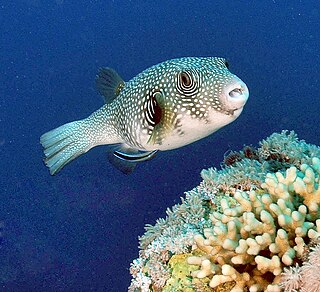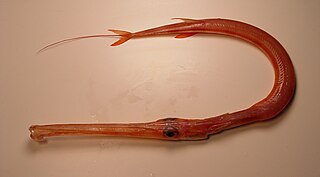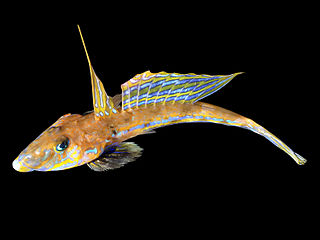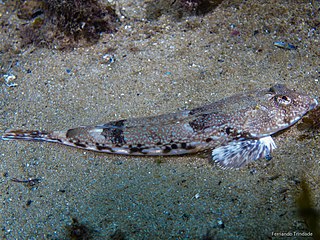
Dragonets are small, percomorph, marine fish of the diverse family Callionymidae found mainly in the tropical waters of the western Indo-Pacific. They are benthic organisms, spending most of their time near the sandy bottoms, at a depth of roughly two hundred meters. There exist 139 species of the fish, in nineteen genera.

The white-spotted puffer fish is a medium to large-sized puffer fish, it can reach 50 cm length. It is light grey in color, or greyish or yellowish, and clearly covered with more or less regular white points, that become concentric contrasting white and dark grey lines that radiate around the eyes and pectoral fins. The ventral part is white. The "shoulder" is dark. It also has concentric contrasting white and dark grey lines that radiate around the eyes and pectoral fins. The white spotted puffer fish is poisonous.

The striped beakfish is a species of marine ray-finned fish, a knifejaw from the family Oplegnathidae. It is native to the north-western Pacific Ocean, though a smattering of records exist from other localities in the eastern Pacific such as Hawaii and Chile. Recently introduced – probably via ballast water – in the central Mediterranean, it is found very rarely from Malta to the northern Adriatic.

Psenes pellucidus, the bluefin driftfish, is a species of driftfish native to the Atlantic, Indian and Pacific oceans where it is found in deep waters to a depth of 1000 m. ). It is also present in low abundance since the mid-20th century in the western Mediterranean Sea which it most likely entered via the Strait of Gibraltar. It can reach a length of 80 cm TL.

The red cornetfish, also known as the rough flutemouth, is a cornetfish of the family Fistulariidae, found in subtropical and tropical oceans worldwide, at depths between 10 m (33 ft) and 200 metres (660 ft). They are up to 2 m (6.6 ft) in length but rarely exceed 1 m (3.3 ft).

Callionymus is a genus of dragonets found mostly in the Indian and Pacific oceans with a few species occurring in the Atlantic Ocean.
The spiny blaasop is a species of pufferfish. Originally native to the Indian Ocean, the southwestern Pacific Ocean and the Atlantic Ocean along the coast of South Africa, it has recently colonised the Levantine waters of the Mediterranean Sea, most likely as a Lessepsian migrant from the Red Sea or in ballast water. This species grows to a length of 5–15 cm. It is the only species in its genus.

The bartail flathead, also known as the Indian flathead, gobi or Indo-Pacific flathead, is a species of largely marine ray-finned fish belonging to the family Platycephalidae, the flatheads. This species is found in the Indian Ocean and the Western Pacific Ocean, and has invaded the eastern Mediterranean Sea.

The lancer dragonet, Baird's dragonet, coral dragonet or St Helena dragonet, is a species of dragonet native to the warmer waters of the Atlantic Ocean where it occurs at depths of from 1 to 91 metres. In the western Atlantic it occurs from Cape Hatteras southwards along the east coast of North America. including Bermuda and the Bahamas, into the Gulf of Mexico and throughout the Caribbean Sea. It has also been recorded from Ilha da Trindade off Brazil. In the eastern Atlantic it has been recorded from the Cape Verde Islands, Ascension Island, St. Helena, and Sao Tome e Principe in the Gulf of Guinea. This species grows to a length of 11.4 centimetres (4.5 in) TL.

The delicate dragonet is a species of dragonet native to the Red Sea through the Indian Ocean to the western Pacific Ocean. It occurs at depths of from 1 to 20 metres. This species grows to a length of 6 centimetres (2.4 in) TL.

The common dragonet is a species of dragonet which is widely distributed in the eastern North Atlantic where it is common near Europe from Norway and Iceland southwards. It is a demersal species that occurs over sand bottoms. It lives to a maximum age of around seven years. It is caught in bycatch by fisheries and is used in the aquarium trade.
The spotted dragonet is a species of dragonet native to the eastern Atlantic Ocean and the Mediterranean Sea where it occurs at depths of from 45 to 650 metres. This species is important to local peoples engaged in subsistence fishing.

The sailfin dragonet is a species of dragonet common in the Eastern Atlantic, where it occurs on the Portuguese coast to as far north as Lisbon and south to Morocco, and also in the northern Mediterranean including the Adriatic, Aegean and Black seas as well as the coastsLebanon and Israel. It occurs on the southern Mediterranean shore as far east as Tunisia Males of this species grows to a length of 14 centimetres (5.5 in) TL while females reach a length of 10 centimetres (3.9 in) TL. In the areas of the Mediterranean where it occurs it is one of the commonest dragonet species, as it is the only species that has been recorded within many protected areas. It is a benthic species which occurs in shallow waters and prefers sandy bottoms down to 100 metres (330 ft). The males are territorial, aggressively defend their territories from other males and like other dragonets this species undergoes complex breeding behaviour which has 4 phases. This starts with courtship, the male and female then form a pair before ascending to the surface where they release eggs and milt. The spawning season runs from May to August in the Mediterranean and the eggs and larvae are pelagic. This species feeds mainly on small benthic invertebrates such as worms and small crustaceans.

The reticulated dragonet is a species of dragonet native to the northeastern Atlantic Ocean and the Mediterranean Sea where it is found at depths of from 0 to 110 metres. This species grows to a length of 11 centimetres (4.3 in) TL. This species has a flattened head and body, the head has a triangular shape with the eyes placed on the top of the head. It has two dorsal fins with the first one being triangular in shape. It has blue spots along the flanks and four saddle-like markings on their backs which have sharply defined outlines. It is similar to the common dragonet but is distinguished by its smaller size and the sharply defined border around the saddle markings on the back.

Risso's dragonet is a species of dragonet native to the Mediterranean Sea as well as the Black Sea and rarely found off of Portugal in the Atlantic Ocean. This species can be found at depths of from 15 to 150 metres. Males of this species grows to a length of 11 centimetres (4.3 in) TL while females reach a length of 6.5 centimetres (2.6 in).

Petroscirtes ancylodon, the Arabian fangblenny, is a species of combtooth blenny found in the western Indian ocean, and since 1989 recorded on occasion in the Levantine waters of the Mediterranean Sea, a likely entry from the Suez Canal. Males of this species reach a length of 11.5 cm TL while females reach a maximum length of 7.9 cm SL.

The lesser amberjack, also known as the false amberjack or little amberjack, is a species of ray-finned fish from the family Carangidae, the jacks and pompanos.
Synchiropus sechellensis, the Seychelles dragonet, is a species of marine ray-finned fish, a dragonet from the family Callionymidae. It is found in the Indo-Pacific from the Red Sea south to the Seychelles and the Maldives and east as far as New Caledonia. Following a likely introduction via the Suez Canal, it was first recorded in the Mediterranean Sea in 2014; where it is found on rare occasions from Alexandria (Egypt) to the Gulf of Antalya (Turkey).
Lagocephalus suezensis is a species of pufferfish of the family Tetraodontidae. It is native to the western Indian Ocean and recorded in the Mediterranean Sea since 1977. It has since spread in the eastern Mediterranean Basin. It reaches 18 cm in total length and inhabits sandy and muddy bottoms down to 40 m. It is often confused with Lagocephalus sceleratus in Australia.












